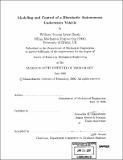| dc.contributor.advisor | Anuradha M. Annaswamy. | en_US |
| dc.contributor.author | Booth, William Duncan Lewis | en_US |
| dc.contributor.other | Massachusetts Institute of Technology. Dept. of Mechanical Engineering. | en_US |
| dc.date.accessioned | 2007-08-29T20:29:13Z | |
| dc.date.available | 2007-08-29T20:29:13Z | |
| dc.date.copyright | 2006 | en_US |
| dc.date.issued | 2006 | en_US |
| dc.identifier.uri | http://hdl.handle.net/1721.1/38565 | |
| dc.description | Thesis (S.M.)--Massachusetts Institute of Technology, Dept. of Mechanical Engineering, 2006. | en_US |
| dc.description | Includes bibliographical references (leaves 137-138). | en_US |
| dc.description.abstract | Current research into Autonomous Underwater Vehicles (AUVs) has included work on biologically inspired propulsion mechanisms, for instance flapping foils. The first aim of this thesis is to develop an accurate non-linear model of a flapping foil AUV, including the forces and moments due to the flapping foil propulsion. The non-linear model is based on standard characteristic equations for a six degree of freedom problem, with components due to hydrostatics (vehicle weight and buoyancy), hydrodynamic damping (body drag), added mass, coriolis forces and the net forces and moments due to the motion of the six flapping foils. The instantaneous model of the flapping foil consists of an analytical model of the angle of attack with respect to the free stream flow. The model depends on empirically derived coefficients of lift (CL), chordal force (Cc) and drag (CD). The second aim of this thesis is to test the flapping foil AUV model open loop. Two tests are performed: a square wave pitch and yaw command. This data will provide a degree of confidence in the flapping foil AUV model, or highlight the need for additional characterization of certain vehicle parameters. | en_US |
| dc.description.abstract | (cont.) The final aim of this thesis is to design a closed loop strategy and repeat the tests performed on the open loop system. We use feedback linearization which attempts to cancel the system non-linearities, and thus specify the system response exactly. It is demonstrated that the tracking performance of the closed loop control system is satisfactory. | en_US |
| dc.description.statementofresponsibility | by William Duncan Lewis Booth. | en_US |
| dc.format.extent | 138 leaves | en_US |
| dc.language.iso | eng | en_US |
| dc.publisher | Massachusetts Institute of Technology | en_US |
| dc.rights | M.I.T. theses are protected by copyright. They may be viewed from this source for any purpose, but reproduction or distribution in any format is prohibited without written permission. See provided URL for inquiries about permission. | en_US |
| dc.rights.uri | http://dspace.mit.edu/handle/1721.1/7582 | |
| dc.subject | Mechanical Engineering. | en_US |
| dc.title | Modeling and control of a biorobotic autonomous underwater vehicle | en_US |
| dc.type | Thesis | en_US |
| dc.description.degree | S.M. | en_US |
| dc.contributor.department | Massachusetts Institute of Technology. Department of Mechanical Engineering | |
| dc.identifier.oclc | 154713607 | en_US |
